

3 clicks could equal $25,000
Why would you not?
Vote for ALL Sikh organizations.
Stop putting it off, competition ends THIS THURSDAY!
 The use of social video sites by our community has seen an upward trend. Of course, many readers of this blog will instantly recognize individuals that have emerged in the last two to three years using YouTube and other social media sites – Mandeep Sethi, Humble the Poet, JusReign, and IISuperwomanII are but a few of the commonly recognized names from North America alone.
The use of social video sites by our community has seen an upward trend. Of course, many readers of this blog will instantly recognize individuals that have emerged in the last two to three years using YouTube and other social media sites – Mandeep Sethi, Humble the Poet, JusReign, and IISuperwomanII are but a few of the commonly recognized names from North America alone.
As it becomes more accessible, we are also seeing the emergence of more grassroots-level use of social video. This medium has allowed Sikhs, and particularly Sikh youth, to express themselves to an unprecedented audience size, and there are several organizations encouraging Sikhs to make use of this platform. For example, SikhNet has been running their Youth Online Film Festival since 2006, and the Sikh Coalition is also holding their third annual Diversity Video Competition for its third consecutive year.
Recently, Manbeena Kaur, the Sikh Coalition’s Education Director, was good enough to answer some questions about the use of social video for the purposes of Sikh education and awareness.
Last month our friends over at Sepia Mutiny posted an interview with Montreal-based hip hop producer Sikh Knowledge, which I think many TLH readers will find of interest. Sikh Knowledge aka Kanwar Anit Singh Saini has worked with many favorite Sikh hip hop artists including Humble the Poet, Mandeep Sethi, and Hoodini and breaks stereotypes right and left as he carves out his own path.
[W]hat really made an impression on me was Sikh Knowledge’s confidence in pursuing his life. At the age of 20, he decided to stop being what other people wanted him to be, dropped out of engineering school and re-started honestly. “I dropped out, came out, and rearranged my whole life,” he stated. “I reapplied and did my undergraduate degree in music with a minor in linguistics. It was the happiest time of my life. I felt good about the decisions that I made.” He’s currently pursuing his Master degree in speech language pathology while having the dual career of mixing some of the ill-est beats in North America.
You read right, Sikh Knowledge is an out and gay hip hop tattooed turban wearing artist. “I’ve definitely lost friends along the way,” he said. “Working relationships have gone sour. But at the end of the day, those artists that choose to work with me… not because of how I can brag, but because of what I do. They’re working with an underdog. That just proves to me that I’ve got something to offer.”
“As an out hip hop, dancehall artist,” he continued. “…people hear the music first and then they reach out to me and we make tracks. Subsequent to that if they find out if I’m gay, my philosophy is that’s their problem. It’s not something I wear on my sleeve but I don’t hide it either.”

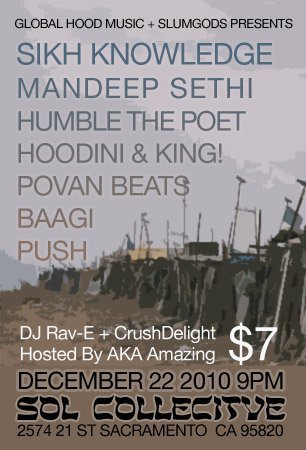 So, in the new year we’ll be bringing about some changes to TLH and we hope that one of these changes will be a better way of highlighting events happening in and around North America.
So, in the new year we’ll be bringing about some changes to TLH and we hope that one of these changes will be a better way of highlighting events happening in and around North America.
In the meantime, for our California Langar Hall family, you can catch Sikh Knowledge + Mandeep Sethi + Humble the Poet + Hoodini & King! + Povan Beats + Baagi + Push at Sol Collective on December 22nd starting at 9pm. The event will be hosted by the very funny AKA Amazing.
Please view the facebook event page here and a video below highlighting many of these artists. The video is filmed by the very talented, Digitology.
Though Sikhs have settled all around the world, roughly 20 million Sikhs still reside in Punjab. There, and elsewhere, Sikhs are facing serious problems including, but not limited to: farmer suicide, female infanticide, drugs and alcohol abuse, domestic violence, economic disasters, disease, poverty, illiteracy, and much more. [Lahir Press Release]
Many of my most recent posts have been about upcoming events happening in the Sikh Community. I think this is a positive sign – that rather than idly discussing and debating issues that inflict our panth, we are actually doing something about it! I would like to highlight two upcoming events occurring in North America. These platforms will bring together talented youth to raise awareness and by doing so, will aim to address important issues within our community. Please support these endeavors so that we can continue to move our panth in the right direction.
Lahir: Save Punjab. Save Ourselves | New Jersey | November 20th | 6pm
Lahir: Move the Movement 2010 is a night of spoken word, poetry, music, and the arts. Artists will include G.N.E., Hoodini, Mandeep Sethi, Gunjiv “Baagi” Singh, MC G-Singh and Humble the Poet. The event will kickoff the movement to respect and protect Punjab by donating all profits to the Baba Nanak Education Society (BNES), an organization which provides humanitarian assistance in rural Punjab to next of kin of suicide victims. These are families with small children left completely destitute by the death of bread-winners and have been neglected by the government. A donation of approximately $350 can help support one family for a year. For more information, visit the facebook page.
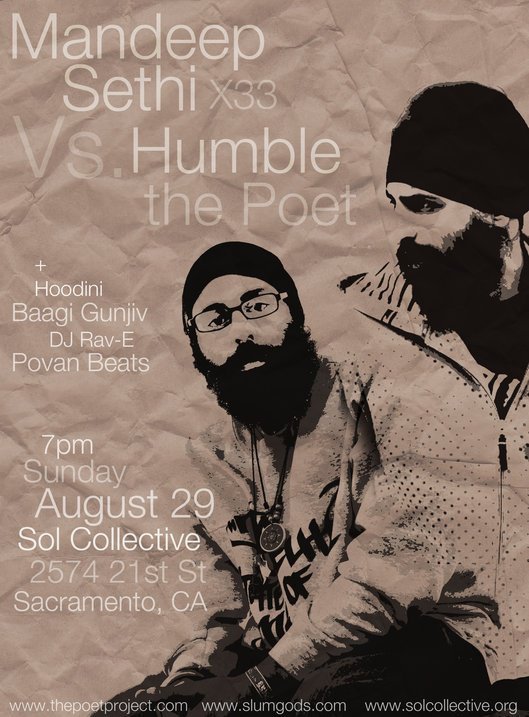 For those of you who will be in or around Northern California [actually, if you’re in or around North America you should come!] be sure to check out this upcoming event featuring Humble the Poet, Mandeep Sethi, Hoodini, Baagi Gunjiv, DJ Rav-E and more.
For those of you who will be in or around Northern California [actually, if you’re in or around North America you should come!] be sure to check out this upcoming event featuring Humble the Poet, Mandeep Sethi, Hoodini, Baagi Gunjiv, DJ Rav-E and more.
This is the first event of its kind in the U.S. (we usually are envious about these events when they happen in Canada!). The show will bring together these artists for, what promises to be, a legendary event.
::Slumgods.com Presents::
Humble the Poet VS Mandeep Sethi
::Live Beats::
::Special Guests::
Hoodini & KinG! + Baagi Gunjiv
::Gully Poetry by::
Sasa [Sick Spits]
::Holding Down the Cuts::
The event will be taking place on SUNDAY AUGUST 29TH from 7-11pm at Sol Collective/2574 21st St/Sacramento, CA 95818
Below the jump you can preview Mandeep Sethi and Hoodini&KinG!
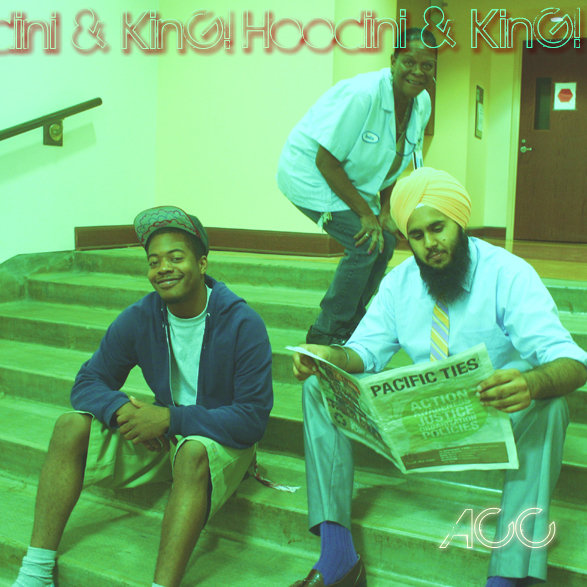 Here on TLH, we’ve covered a variety of talented musicians including Sikh Knowledge, Mandeep Sethi and Humble the Poet. We’ve been following these individuals, their music, new collaborations and of course new albums. I am a huge believer that youth (yes, we have a particular interest in Sikh youth here in TLH) should be encouraged to pursue their talents regardless of what may be expected of us. These musicians are doing just that – and they are creating incredible music that speaks to the masses.
Here on TLH, we’ve covered a variety of talented musicians including Sikh Knowledge, Mandeep Sethi and Humble the Poet. We’ve been following these individuals, their music, new collaborations and of course new albums. I am a huge believer that youth (yes, we have a particular interest in Sikh youth here in TLH) should be encouraged to pursue their talents regardless of what may be expected of us. These musicians are doing just that – and they are creating incredible music that speaks to the masses.
This post is for Hoodini & KinG. I have to say Hoodini is one my favourites. Not only is he extremely talented (listen to track 6/Keep it Rollin’ and track 10/Til I’m Through of the mixtape) but he’s a nice guy (a really nice guy)… and the kid has serious style. It’s like he knows he’s going to make a mark on the world, and is dressed for the occasion…
So i didn’t mean to just mention this mixtape in passing – you really have to download and listen to it yourself. It is a really dynamic piece of work. Hoodini & KinG! Present: A California Classic, is available here. While Hoodini is the emcee, the album was produced by KinG! né Keith Rice – a 21 year old producer from the San Fernando Valley in Los Angeles (he’s really really talented). Even though the two went to different high schools, their mutual love of hip-hop was destined to bring their forces together so that they could make music that would “make people fall in love again.”
I asked Hoodini what inspires him and what he told me was this,
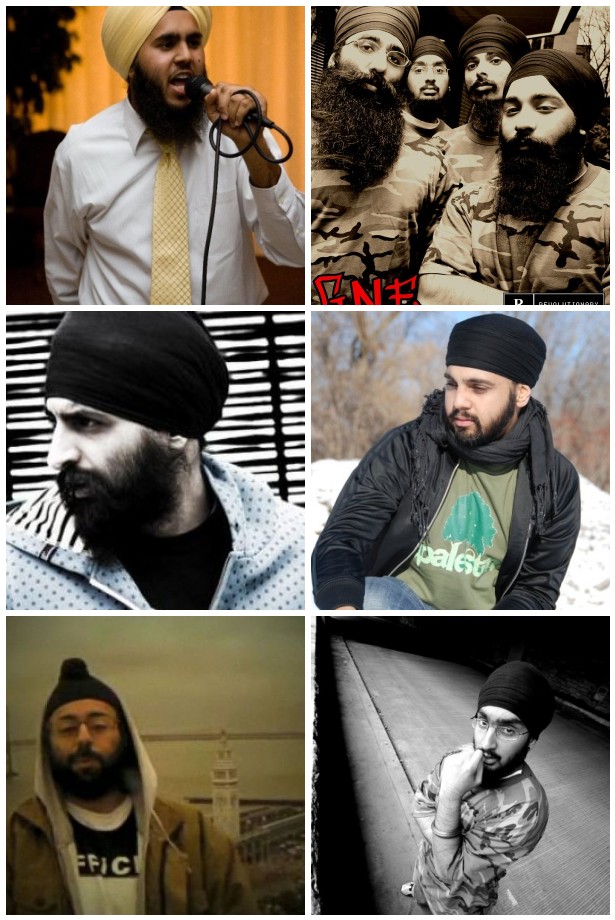 While everyone seems to be pretty excited about Kamaljit topping the Billboard charts – it seems that Jay Sean is not the only musician from our community who is gaining a ton of attention lately. In the October/November 2009 issue of East West magazine, an article by Navdeep Singh Dhillon titled, “The Brown Underground” discusses the five new names in hip-hop worth knowing. While on TLH we have featured these names in previous posts and are fans of their work – we wanted to highlight this new article as it provides a very intimate look at these artists. Musicians, rappers, emcees or whatever you may call them – they, at the end of the day, are regular guys (believe me, they are). They work, they go to school, they feel strongly about adversities that are going on all over the world. Unlike many, however, they are using their talent to channel that emotion into creativity and into their music. We definitely like what we’re hearing and whether they know it or not, these artists are paving a path for generations to come.
While everyone seems to be pretty excited about Kamaljit topping the Billboard charts – it seems that Jay Sean is not the only musician from our community who is gaining a ton of attention lately. In the October/November 2009 issue of East West magazine, an article by Navdeep Singh Dhillon titled, “The Brown Underground” discusses the five new names in hip-hop worth knowing. While on TLH we have featured these names in previous posts and are fans of their work – we wanted to highlight this new article as it provides a very intimate look at these artists. Musicians, rappers, emcees or whatever you may call them – they, at the end of the day, are regular guys (believe me, they are). They work, they go to school, they feel strongly about adversities that are going on all over the world. Unlike many, however, they are using their talent to channel that emotion into creativity and into their music. We definitely like what we’re hearing and whether they know it or not, these artists are paving a path for generations to come.
The article highlights the work of Canadian-based Humble the Poet and Sikh Knowledge, D.C.-based Saint Soulja of G.N.E., Hoodini from Los Angeles and Mandeep Sethi from San Francisco. You can read about their quest into this industry and how being a Sikh plays a role (or does not) in their music. What’s clear about these artists is that while they are Sikh, they don’t necessarily only rap about Sikh issues or only about issues affecting our community and that’s what makes them stand out in my mind. Injustice to any group is an injustice to humanity and as Sikhs, that is something we should resist. We can rest assured that these artists are having that dialogue.
In many ways, the Punjabi-Sikh art scene is expanding exponentially these days. Just 10 years ago, beyond major, mainstream singers, I don’t think there was an arts scene, except maybe in people’s homes. Today, there are film festivals in most major cities like Spinning Wheel and the upcoming Sikh Heritage Film Fest in NY, art exhibits in museums such as the recent exhibit at NY’s Rubin Museum and current exhibit at the London’s Victoria and Albert, and even spoken word shows like When Lions Roar and Lahir. There are independent artists writing thoughtful lyrics, creating original beats, and giving some of our community’s concerns a voice. One of my favorites from this summer is Humble the Poet’s “Singh with Me” featuring Sikh Knowledge.
Yet, while the number and modes of art and artists grows in our community, many mainstream musicians are following  mainstream trends… videos featuring flashy cars rented for the shot, women as props, all at some party. Maybe they’re catering to what they think the audience wants, but the audience is clamoring for what they see as glamorous… which is manufactured to cater to the whims of the audience. This degenerative, downward spiral has led to recent hits such as RDB’s “Om Mangalam.” (See end of post.)
mainstream trends… videos featuring flashy cars rented for the shot, women as props, all at some party. Maybe they’re catering to what they think the audience wants, but the audience is clamoring for what they see as glamorous… which is manufactured to cater to the whims of the audience. This degenerative, downward spiral has led to recent hits such as RDB’s “Om Mangalam.” (See end of post.)
RDB is clearly identifiable as Punjabi-Sikh (let’s not talk about who’s a good or bad Sikh- that’s boring), wearing the now fashionable Palestinian support scarf, and singing Om Mangalam in this video on the homepage of their official site. This is definitely a case of trying to do too much and doing it all badly. There’s nothing inherently wrong with being Punjabi, singing Hindi music (while wearing a Palestinian support scarf), in a video with meaningless lyrics. It’s just not art. Some might call it entertainment, though I’d call it a train wreck.
Last week, I wrote a wrap-up about the 10th Annual Jakara Movement Conference. Sikh Knowledge, a previously featured artist, wrote his thoughts on his blog.
However, an especially important post was written by Pashaura Singh Dhillon. For those that are regular langa(r)-eaders, then you need no introduction. In a post during last year’s presidential election, I introduced a Fresno Punjabi landmark – one of our many great poets.
At last week’s Jakara Movement Conference, Pashaura Singh delivered a powerful poem at the farewell banquet. On his own blog, he introduces the piece, written with a contemporary problem using a traditional Mirza meter. I quote at length:
I was invited to share a poem I wrote at the closing banquet of Jakara Movement. Jakara began in 2000 with a mission to call the next generation of Sikhs from all places, backgrounds and points of view to reflect on their past and prepare for the future. In 2009, they came together as the next generation of Sikhs to continue the process of empowering, engaging , and educating the Sikh community.
Kanwar Anit Singh Saini (Sikh Knowledge) and Kanwar Singh (Humble the Poet), two Canadian rappers and participants of 2009’s Jakara said it best. “1984 is all around us. It is happening in Rwanda. It is happening in Palestine. We should try to find connections with people who are also victims because then the minority becomes the majority.”
But I was not there to repeat what had already been reported or was going to be reported on this subject. As a poet I wanted to invite them to a different plane, whereby they not only take the message of what happened to the Sikhs 25 years ago but also what is happening all around the world today and how it relates to us all. A big picture where these compounded atrocities and excesses not only of humans on humans that are happening everyday but also collectively of humans on this planet Earth, which threatens its very survival. The victim of human’s inhumanity the Earth pleads with the princess of the Skies whose domain the fugitive from Earth is now so impatient to intrude. Without further adieu, here is “Umber Di Shehzadi De Naa: To the Princess of the Skies”

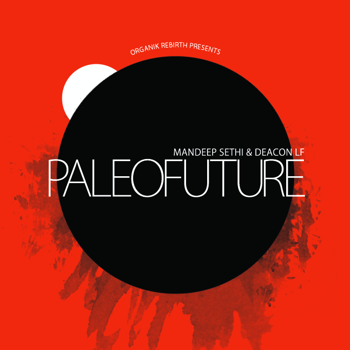 I know I have been posting about it much lately, but as full disclosure compels, I have helped with the organization in the past. A few weeks ago I posted about this weekend When Lions Roar in Toronto and Vancouver. It seems in the wake we have something in the making in Central California, Fresno. For regular readers of The Langar Hall, you’ve been introduced to the talents and music of Sikh Knowledge, Humble the Poet, GNE’s Saint Soulja, and even Mandeep Sethi. As a side note, Mandeep has the most amazing track I have ever heard by a hip-hop artist on 1984. Make sure to check it out.
I know I have been posting about it much lately, but as full disclosure compels, I have helped with the organization in the past. A few weeks ago I posted about this weekend When Lions Roar in Toronto and Vancouver. It seems in the wake we have something in the making in Central California, Fresno. For regular readers of The Langar Hall, you’ve been introduced to the talents and music of Sikh Knowledge, Humble the Poet, GNE’s Saint Soulja, and even Mandeep Sethi. As a side note, Mandeep has the most amazing track I have ever heard by a hip-hop artist on 1984. Make sure to check it out.
This month they will all be attending, participating, and performing at the Jakara Movement’s annual conference. With few seats left and this major addition, you will not want to miss this year’s conference as we come together to “Remember 1984.” The dates are June 18-21, 2009. Register TODAY to avoid a late fee. See you in Fresno.
He locked the washroom door, unravelled the nine-metre turban, took a pair of scissors and started cutting. Ten minutes later, three feet of hair lay in a pile and Charanbir Singh sat down and cried.
Outside, his parents and grandmother were in tears. Two friends persuaded him to come out, but Charanbir, his head wrapped in a towel, rushed to his room.
That was a year ago. Charanbir, now 17, still shudders at the memory. “I had to cut my hair.” (Link)
One of ironies of life in the 21st century western world is that despite an unparalleled degree of freedom of religion, the majority of people seem to be opting for freedom from religion.
Last week, Raveena Aulakh, a reporter from the Toronto Star, put a Canadian twist on the worldwide issue of apostasy amongst Sikh Youth.
Sikhism dates back to 15th-century India. Adherents are required to not cut their hair, considered a visible testament to their connection with their creator. The turban was adopted to manage long hair and make Sikhs easily identifiable.
For many young men in Greater Toronto, that is the problem: They don’t want to stand out.
Like other new or second-generation immigrants, many Sikh youngsters are desperate to fit in with the school crowd, while others complain of racism because they wear the turban. Add to that cultural influences, peer pressure and the desire to assimilate.
The end result? Many youngsters cut their hair, leading to family friction and, in some cases, lasting estrangement.
As a counterpoint, in the article and video above, Pardeep Singh Nagra (of boxing fame) presents his thoughts on why he’s decided to keep his hair.
Fear & Guilt
I’ve often wondered why so many Sikh youth keep their hair through high school but cut it as soon as they feel free from their parent’s control? From my perspective I see this as symptomatic of a great challenge facing Sikhs around the world today. Somehow, someway, we have fallen into the trap of pushing Sikhi to the next generation with fear and guilt, rather than sharing Sikhi through love.
Take your typical Sikh family; actually take mine. My now 25 year old cousin in Punjab had wanted to cut his hair since he was a teenager but two things stopped him. He was afraid that if he cut his hair his dad would beat him and then disown him. Secondly, he knew that if he did get a haircut and shave he wouldn’t be able to look his crying mom in the eye.
Unfortunately, there was little positive reinforcement around Sikhi in his life. Sure there was Sikhi by osmosis: visiting Gurdwaras, gurbani playing in the background, the odd sakhi told by our visiting grandfather. However, my cousin had little exposure to the aspects of Sikhi (nitnem, kirtan, seva, simran) that would have connected him with his faith on a deeper level. Most of the discussions with his parents were a flavour of the famous Goodness Gracious Me clip. So not surprisingly, upon entering college, he too cut his hair. And sure enough, he became our family’s black sheep, making a kid with already low self-esteem, feel even worse.
It seems like Canada is showcasing one socially conscious Sikh rapper after another. TLH has covered “Humble The Poet” and now here is “Sikh Knowledge” from Montreal. Sikh Knowledge raps with Lotus on issues effecting the 2nd generation and marginalized peoples.
Kanwar Anit Singh Saini, a.k.a. Sikh Knowledge, is the son of Punjabi Sikh immigrants. He works in the field of speech pathology where he contributes his musical knowledge to the health sciences field.
Check out his songs below and let us know what you think!
Disclaimer: There are graphic descriptions and swear words in the videos below.
Skimming the other Sikh blogs, I found this post (on a great blog that I am starting to like and not just because he is also an Immortal Technique fan) about a Sikh conscious rapper from Toronto. Although I couldn’t find too much on the internet about Kanwer Singh, other than the fact he is a recent college graduate, the comments on his works have received much praise on youtube. Kanwar goes by Humble the Poet (maybe an allusion to Bhat Bani? SGGS 1400). I personally found this track amazing. (Don’t worry Joolz/Bobby/Suzy, no bad language here)
The track deals with a number of incidents that have plagued the Punjabi Sikh community in Toronto, Canada (although unfortunately Kitimat is there too). However these problems are hardly limited to Canada. They are the stories of our diaspora. From male youth violence, AIDS, domestic violence, alcohol abuse, and drug abuse, this song hits on it all. In fact many of these are themes that get talked about at the Sikh conference I mentioned yesterday. In case you were interested, you can download Kanwer’s track here.
Looks like I have another favorite Sikh rapper along with Mandeep Sethi from the Bay. Your thoughts?

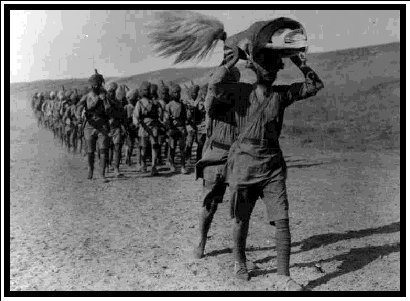 In honor of yesterday’s Gurpurab (Bhadon 17, Nanakshahi) marking the anniversary of the first installation of Guru Granth Sahib Ji Maharaj in the Darbar Sahib, I’d like to share a piece I had written for sikhchic.com at the culmination of last year’s “300 Saal” celebrations, titled “My Guru & I: In His Presence.”
In honor of yesterday’s Gurpurab (Bhadon 17, Nanakshahi) marking the anniversary of the first installation of Guru Granth Sahib Ji Maharaj in the Darbar Sahib, I’d like to share a piece I had written for sikhchic.com at the culmination of last year’s “300 Saal” celebrations, titled “My Guru & I: In His Presence.”
As 2008 comes to an end, I’ve been reflecting on all the “300 Saal” celebrations of the year. It was an inspiring year – and the discussion, speeches and sheer emotion of this milestone really gave me a chance to reflect on the role of the Guru in my life.
While volunteering at Gurmat camps, I always made a point to pose a question to the children, prior to leading them in to their first divan: “If you walked into this Gurdwara and instead of the Guru Granth Sahib being there, say it was Guru Nanak, or Guru Amar Das or Gur Tegh Bahadur, sitting there – how would you act?” How would you carry yourself when walking in? Would your mind-set be any different? Would your muthha tek take on a different meaning? Would you be more attentive and alert during the divan? Would you be more eager to listen to his words and try harder to understand him?
Guru Ram Das says:
Baani Guru Guru Hai Baani Vich Baani Amrit Saarey
Bani is the Guru and Guru is the Bani. And it’s within this Bani, that Amrit is found.
Thus, the Shabad (“The Word”) is, was and always will be the Guru. History tells us that even during Guru Arjan’s time, the Granth (then referred to as the Pothi Sahib because it was yet to be completed and anointed Guru), was the center of the congregation, the center of the Darbar, even in the presence of Guru Arjan himself.
The saakhis tell us that Guru Arjan had so much reverence for the Pothi Sahib that he kept it on an pedestal elevated even from himself, and joined the Sikhs in paying obeisance to it. This tells me that it is not the person, the attire or the physical attributes that make the Guru; instead, it is the Shabad. But we call the ten physical forms (from Nanak to Gobind Singh) Guru because they were the living manifestation of that Shabad.
They lived the Shabad. We sing it, they lived it.



